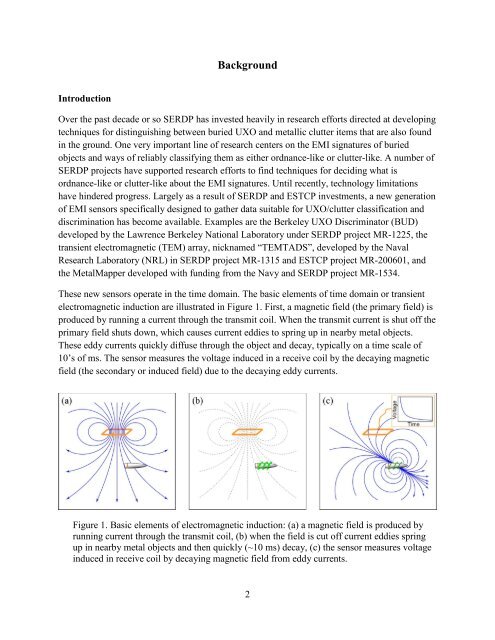Final Report - Strategic Environmental Research and Development ...
Final Report - Strategic Environmental Research and Development ...
Final Report - Strategic Environmental Research and Development ...
- No tags were found...
You also want an ePaper? Increase the reach of your titles
YUMPU automatically turns print PDFs into web optimized ePapers that Google loves.
BackgroundIntroductionOver the past decade or so SERDP has invested heavily in research efforts directed at developingtechniques for distinguishing between buried UXO <strong>and</strong> metallic clutter items that are also foundin the ground. One very important line of research centers on the EMI signatures of buriedobjects <strong>and</strong> ways of reliably classifying them as either ordnance-like or clutter-like. A number ofSERDP projects have supported research efforts to find techniques for deciding what isordnance-like or clutter-like about the EMI signatures. Until recently, technology limitationshave hindered progress. Largely as a result of SERDP <strong>and</strong> ESTCP investments, a new generationof EMI sensors specifically designed to gather data suitable for UXO/clutter classification <strong>and</strong>discrimination has become available. Examples are the Berkeley UXO Discriminator (BUD)developed by the Lawrence Berkeley National Laboratory under SERDP project MR-1225, thetransient electromagnetic (TEM) array, nicknamed “TEMTADS”, developed by the Naval<strong>Research</strong> Laboratory (NRL) in SERDP project MR-1315 <strong>and</strong> ESTCP project MR-200601, <strong>and</strong>the MetalMapper developed with funding from the Navy <strong>and</strong> SERDP project MR-1534.These new sensors operate in the time domain. The basic elements of time domain or transientelectromagnetic induction are illustrated in Figure 1. First, a magnetic field (the primary field) isproduced by running a current through the transmit coil. When the transmit current is shut off theprimary field shuts down, which causes current eddies to spring up in nearby metal objects.These eddy currents quickly diffuse through the object <strong>and</strong> decay, typically on a time scale of10’s of ms. The sensor measures the voltage induced in a receive coil by the decaying magneticfield (the secondary or induced field) due to the decaying eddy currents.Figure 1. Basic elements of electromagnetic induction: (a) a magnetic field is produced byrunning current through the transmit coil, (b) when the field is cut off current eddies springup in nearby metal objects <strong>and</strong> then quickly (~10 ms) decay, (c) the sensor measures voltageinduced in receive coil by decaying magnetic field from eddy currents.2
















